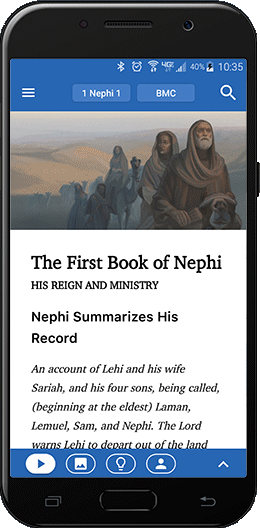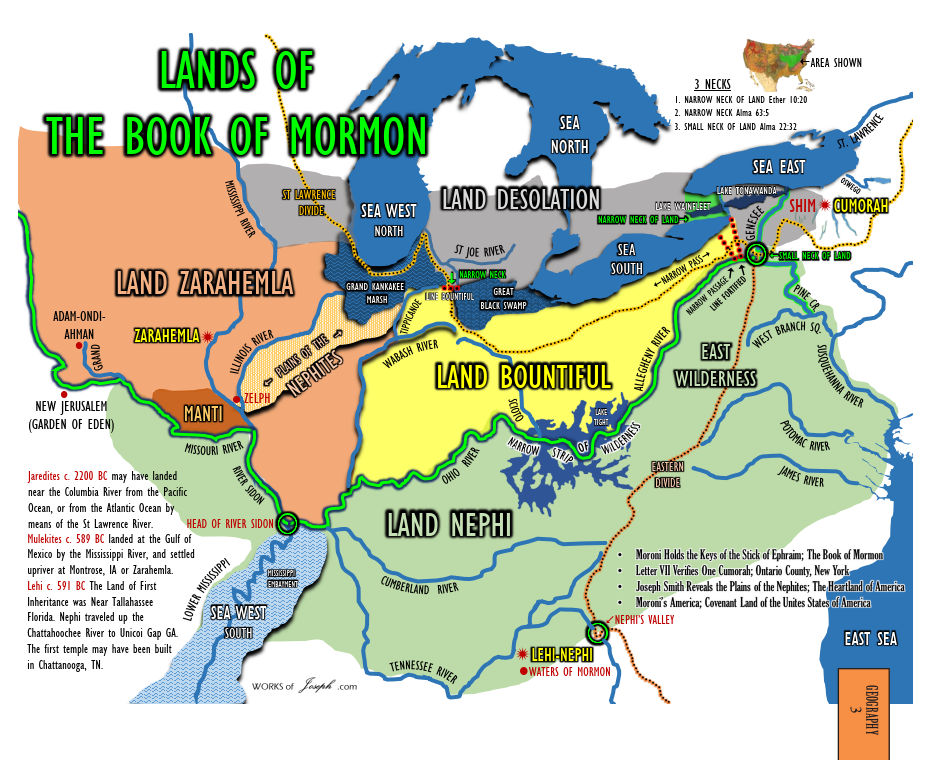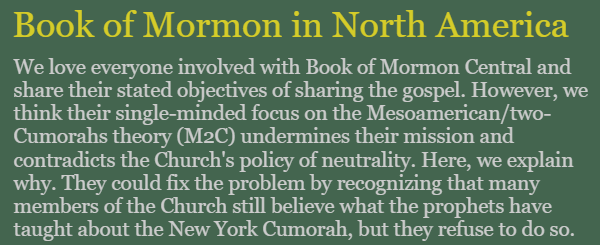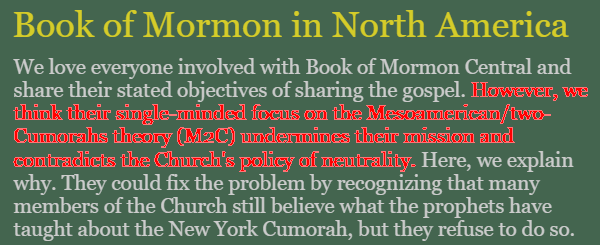(
Part five of a series.)
Jonathan Neville
really doesn’t like
BYU’s Virtual Book of Mormon map. A Google search I ran today on
MoronisAmerica.com, his flagship website, indicates that he’s referred to it as BYU’s “fantasy map” in
131 separate articles on that site.
In a blog post last month, Neville criticized an article in
the fall 2019 issue of BYU Religious Education Review about the Virtual Book of Mormon map. (Neville’s blog post incorrectly states it was in the winter 2019 issue.) The article, “Visualizing the People, Places, and Plates of the Book of Mormon,” was written by
Tyler J. Griffin, an associate professor of ancient scripture at BYU and co-founder of BYU Virtual Scriptures Group. (He’s listed as a member of
the team that created the virtual map.)
Neville framed his blog in light of the Church’s
Gospel Topics essay on Book of Mormon geography. He quoted the essay’s counsel that “all parties should strive to avoid contention” on matters of Book of Mormon geography and then wrote:
The connotation of “contention” in that statement is surely “heated disagreement.” This is wisdom because some people have an emotional, intellectual, or financial interest in a particular position that clouds their judgment and their ability think critically.
Neville wrote that statement without a shred of self-awareness. Remember, this is Jonathan Neville, the man who maintains
67 blogs that he uses almost exclusively to attack the Mesoamerican theory of Book of Mormon geography and those who advocate for it. He claims those who believe in what he calls “M2C”* are “
rejecting the teachings of the prophets” and that there is a
massive conspiracy within Church administration to
censor anything that is contrary to “M2C,” a conspiracy that has
even fooled the First Presidency and Quorum of the Twelve Apostles.
And he has the gall to claim that other people have interests that cloud their judgments and make them unable to think critically?
Glass houses, indeed.
Turning to his assessment of Griffin’s article, let’s look at an example of how Neville misreads Book of Mormon geography while criticizing others for supposedly doing the same thing. In his article, Griffin explains:
Attempts to visually represent geographical features in the Book of Mormon will naturally lead to judgments that may not always match other interpretations of the same passages. For example, we represent wilderness references in the book as mountains on our map. The wildernesses could have just as easily been unclaimed land, swampland, jungle, desert, or any combination of these or other natural features. It is intended that readers will be able to take our internal map and stretch it, compress it, and modify it to fit whatever model they prefer for their own study purposes.
Neville, however, disagrees with Griffin’s decision to represent wilderness ares in the Book of Mormon as mountains. He writes:
Wilderness as “mountains” is the specific M2C interpretation from John Sorenson, Book of Mormon Central, and other M2C proponents.
I once had well-known M2C scholars tell me the Book of Mormon refers to “a narrow strip of mountainous wilderness.” I asked them to show me the passage in the text. Of course, they couldn’t. They were referring to Alma 22, but they had read John Sorenson’s version so many times they thought the text actually said that.…
This axiomatic statement leads us to ask, then why does the fantasy map depict the wilderness as mountains? The answer is simple: the creators and proponents of this map work with Book of Mormon Central and they’re promoting the specific M2C interpretation.
Had they wanted to, the map’s creators could have portrayed a generic “wilderness” instead of depicting and specifying mountains. However, the M2C interpretation requires mountains to work, so that’s what this fantasy map shows.
Firstly, I must point out to our readers that
Jonathan Neville interprets “wilderness” in the Book of Mormon to mean rivers. His Heartland interpretation of the text requires that wildernesses be rivers, so that’s what
his fantasy map shows:
Detail from Jonathan Neville’s book, Moroni’s America – Maps Edition, map 8, “Necks, Lines, Passes, Strips, and the Narrow Neck of Land.” (Click to see the whole map.)
As Joe Anderson notes on pages 28–30 of
his review of Neville’s book,
Moroni’s America, the Book of Mormon never refers to
wilderness as a river. Neville invented that definition because it was the only way he could get the geography of the Book of Mormon to fit into the American Midwest. Yet, in his blog post,
Neville has the temerity to criticize Griffin for displaying wilderness as mountains!
There are, in fact, good reasons to believe that the narrow strip of wilderness that separated the Nephite and Lamanite lands was composed mostly of mountains. (And those reasons go much deeper than “promoting M2C” or being a fan of
Book of Mormon Central.) Here’s the short version:
- The land of Nephi, which was controlled by the Lamanites from the time of King Mosiah¹ onward, was higher in elevation than the land of Zarahemla where the Nephites lived. Whenever one traveled from the land of Nephi to the land of Zarahemla, one went down, while those traveling from Zarahemla to Nephi are described as going up. The Book of Mormon is consistent throughout its text on this point. (See Mosiah 7:2, 4; 9:3; 20:7; 28:1, 5; 29:3; Alma 17:8; 20:2; 24:20; 26:23; 27:5; 29:14; 51:11; 57:15-16, 28, 30; Helaman 1:17.)
- After the death of Kishkumen, Gadianton “feared lest that he should be destroyed; therefore he caused that his band should follow him. And they took their flight out of the land, by a secret way, into the wilderness.” (Helaman 2:11) It was from this wilderness hideout that the Gadianton band of robbers staged hit-and-run attacks against the Nephites and the Lamanites, compelling both groups to take up arms against them (Helaman 6:18; 3 Nephi 2:11–12). So it seems almost certain that the “wilderness” in which Gandiantons lived was the narrow strip of wilderness between the land of Zarahemla and the land of Nephi—it’s the only wilderness that had easy access to both lands.
- The text of the Book of Mormon describes the wilderness where the Gandiantons lived in secret and could retreat to safety from the armies of the Nephites and Lamanites as mountains (Helaman 11:25, 28, 31; 3 Nephi 1:27; 2:17; 3:17, 20; 4:1–3, 13).
- Therefore the narrow strip of wilderness was mountainous, just as the Virtual Book of Mormon map portrays it.
Now, it’s entirely possible to make an argument that the narrow strip of wilderness
wasn’t mountainous, but that would require one to actually use the text of the Book of Mormon in a coherent and reasonable manner.
Neville has not done this. Instead, he’s simply criticized Griffin for inferring something that the Book of Mormon doesn’t directly say, while instead offering his own forced, absurd
wilderness = river interpretation.
If this were the only time that Neville employed such a double standard, this blog wouldn’t exist. Sadly, it’s par for the course for Neville, and so Captain Hook and I are forced to continue to point out to unsuspecting Latter-day Saints the the fraudulent methods he uses to sell the Heartland hoax to unsuspecting Latter-day Saints.
—Peter Pan
* “M2C” is Jonathan Neville’s acronym for the theory that the Book of Mormon took place in Mesoamerica and that the hill Cumorah in the Book of Mormon is not the same hill in New York where Joseph Smith received the plates of Mormon. “SITH teaches that [Joseph and Oliver] misled everyone about the translation.”
“SITH teaches that [Joseph and Oliver] misled everyone about the translation.” “SITH teaches that [Joseph and Oliver] misled everyone about the translation.”
“SITH teaches that [Joseph and Oliver] misled everyone about the translation.” “Merely pretended to translate.”
“Merely pretended to translate.” This is completely bizarre, since, in the preceding paragraph, he recommended Scripture Notes, which apparently isn’t “trying to lure Latter-day Saints away from the Gospel Library,” even though it uses exactly the same approach as ScripturePlus—only with a paid version, which ScripturePlus doesn’t have.
This is completely bizarre, since, in the preceding paragraph, he recommended Scripture Notes, which apparently isn’t “trying to lure Latter-day Saints away from the Gospel Library,” even though it uses exactly the same approach as ScripturePlus—only with a paid version, which ScripturePlus doesn’t have. Of all of Jonathan Neville’s trite expressions, perhaps his favorite is the term “M2C citation cartel.”
Of all of Jonathan Neville’s trite expressions, perhaps his favorite is the term “M2C citation cartel.” Netflix recently debuted their three-part documentary series, “
Netflix recently debuted their three-part documentary series, “ Recently, the
Recently, the  In his latest broadside against any and all things connected to
In his latest broadside against any and all things connected to  This, coming from the man who doesn’t support President Russell M. Nelson, the living prophet, on such a basic topic as
This, coming from the man who doesn’t support President Russell M. Nelson, the living prophet, on such a basic topic as 




 Jonathan Neville’s house, probably.
Jonathan Neville’s house, probably.













